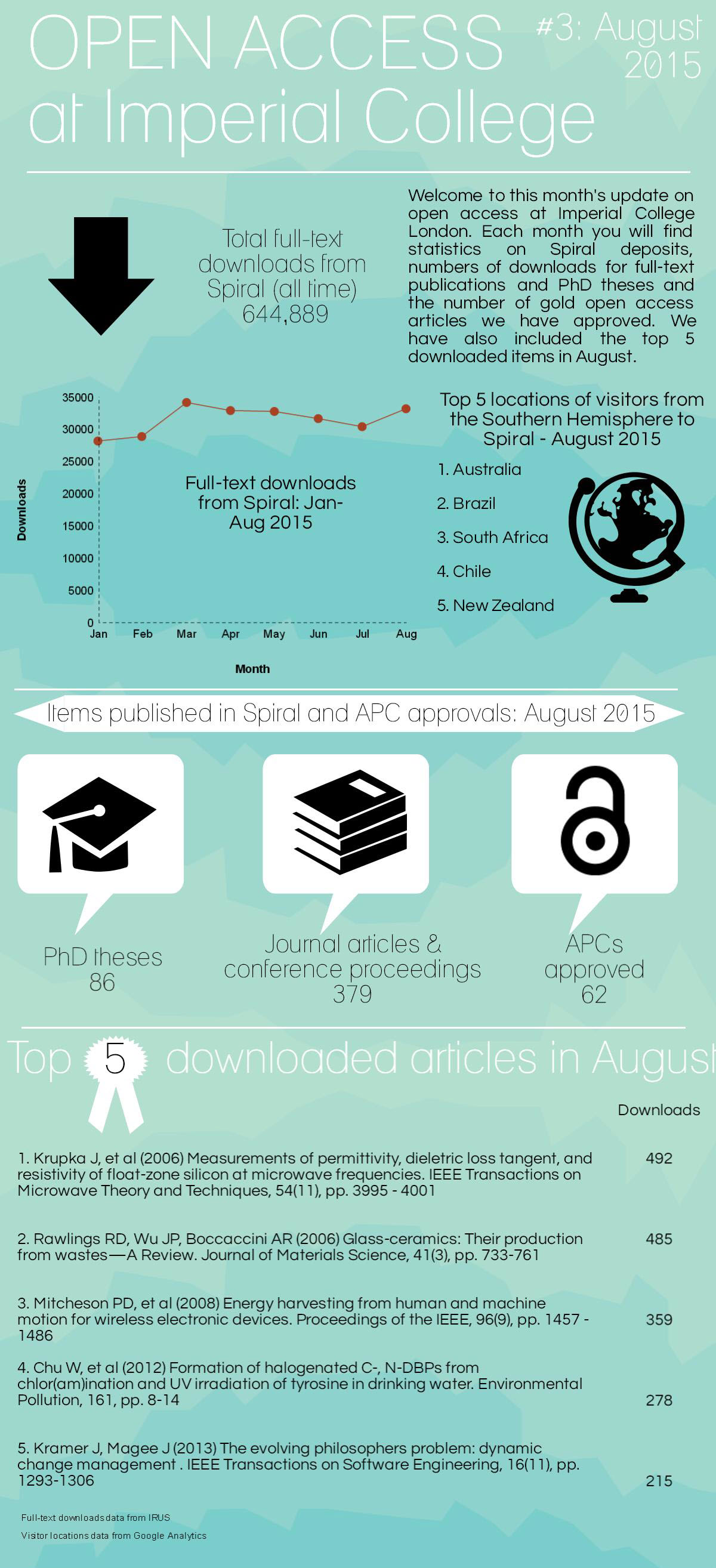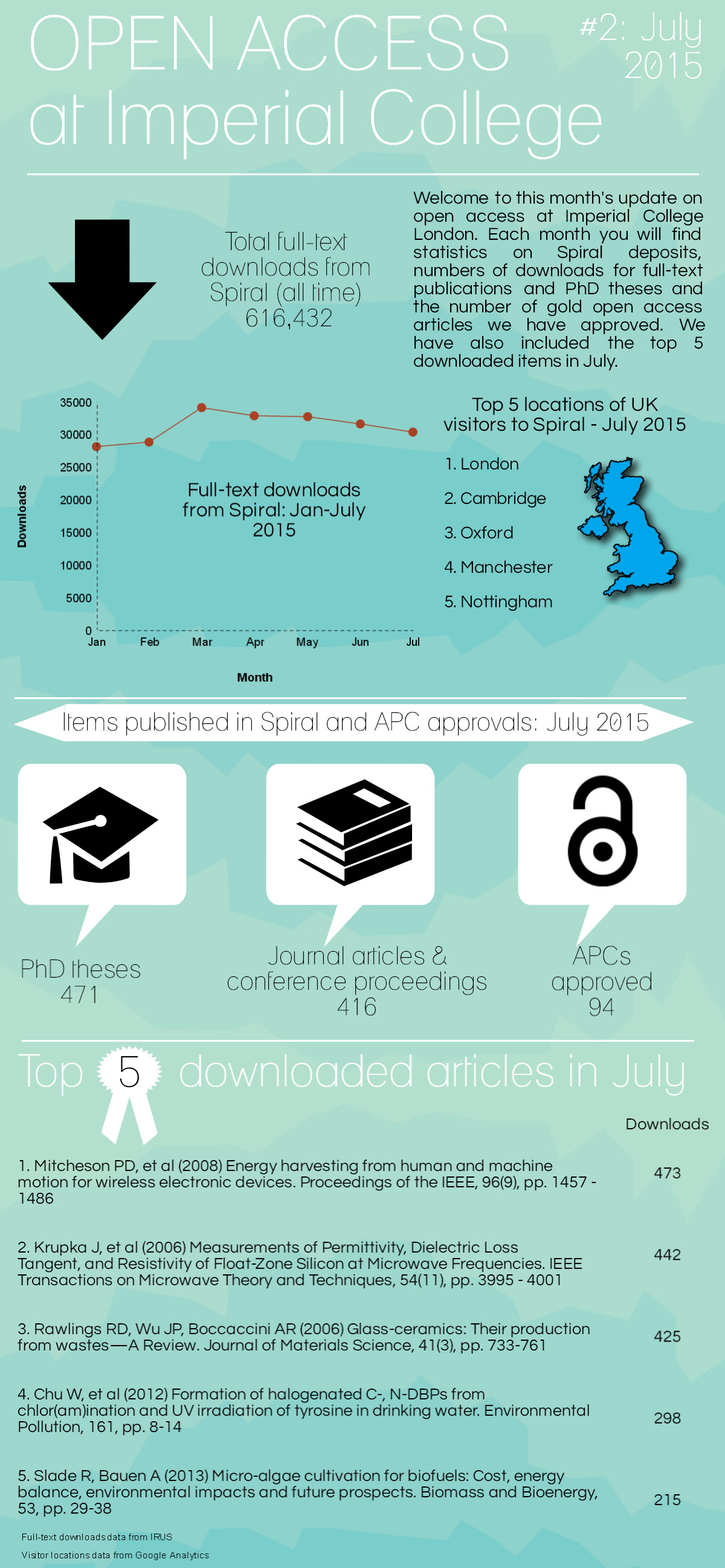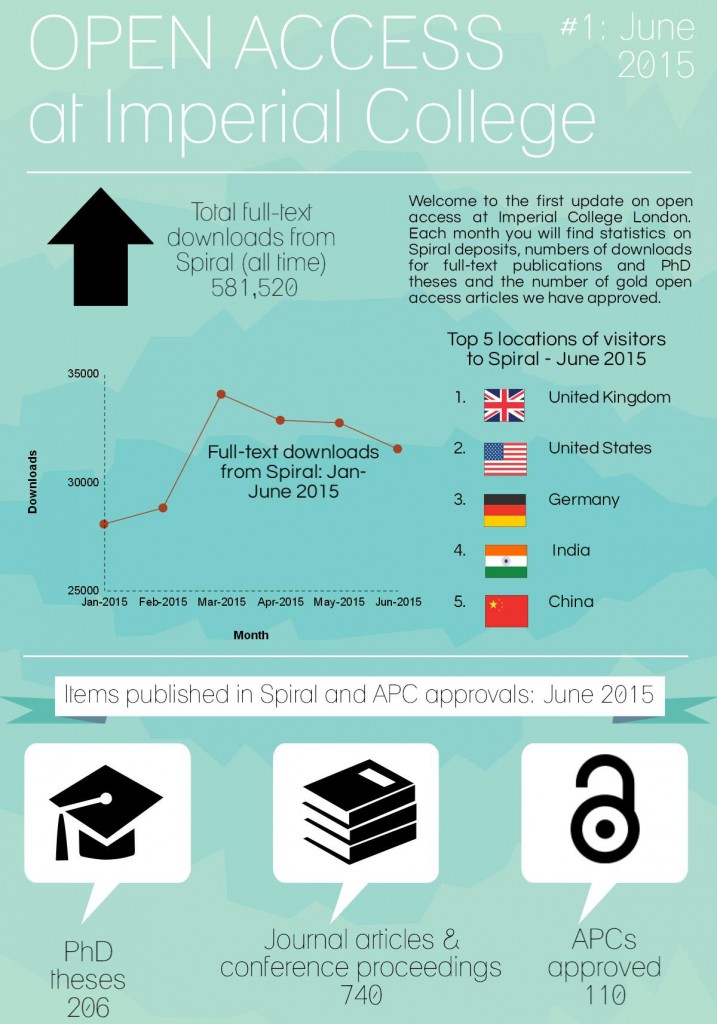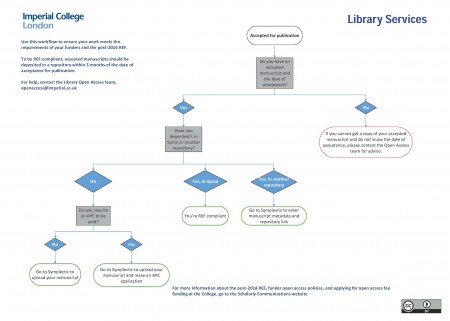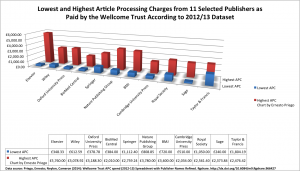Category: OA News
Open access in numbers – July 2015
Open access in numbers – June 2015
New Workflow: “Be REF compliant”
The library has released a new workflow on how to make your publications REF compliant. Authors can now deposit their journal articles and conference proceedings on acceptance in Spiral via Symplectic. At the same time an application can be made for APC funding to pay open access fees.
Find out more about how the library can support you in making your work open access at our new web pages, or contact us: openaccess@imperial.ac.uk.
End of 2014 Open Access news
Just in time before the College closes for the Christmas break I have found the time to write my overdue summary of recent developments in the world of open access and scholarly communication. Below are a few of the headlines and developments that caught my eye during the last couple of months.
Cost of Open Access
Commissioned by London Higher and SPARC Europe, Research Consulting have published Counting the Costs of Open Access. Using data provided by universities, including Imperial College, it concludes that there was a £9.2m cost to UK research organisations for achieving compliance with RCUK’s open access policy in 2013/14. Main conclusions are quoted below – the estimated costs for meeting REF open access requirements are particularly interesting seeing as HEFCE do not provide any funding for their in some ways even more ambitious open access policy:
- The time devoted to OA compliance is equivalent to 110 fulltime staff members across the UK.
- The cost of meeting the deposit requirements for a post-2014 REF is estimated at £4-5m per annum.
- Gold OA takes 2 hours per article, at a cost of £81.
- Green OA takes just over 45 minutes, at a cost of £33.
Pinfield, Salter and Bath published: The ‘total cost of publication’ in a hybrid open-access environment. The study analyses data from 23 UK institutions, including Imperial College, covering the period 2007 to 2014. It finds that while the mean value of APCs has been relatively stable, ‘hybrid’ subscription/OA journals were consistently more expensive than fully-OA journals. Modelling shows that APCs are now constituting 10% of the total cost of ownership for publishing (excluding administrative costs).
EBSCO’s 2015 Serials Price Projection Report assumes price increase of 5-7%, not including a recommended additional 2-4% to allow for currency fluctuations.
John Ulmschneider, Librarian at the Virginia Commonwealth University, estimates that with current price increases the cost for subscription payments would “eat up the entire budget for this entire university in 20 years”. Partly in response to that, VCU has launched its own open access publishing platform.
UK Funder News
Arthritis Research UK, Breast Cancer Campaign, the British Heart Foundation (BHF), Cancer Research UK, Leukaemia & Lymphoma Research, and the Wellcome Trust have joined together to create the Charity Open Access Fund (COAF). COAF operates in essentially the same way as the WT fund it replaces.
An article summarising responses to the RCUK review of open access cites the Wellcome Trust saying that sanctions could accelerate the implementation of open-access.
The Wellcome Trust published a list of journals that do not provide a compliant publishing option.
International Funder News
A new Danish open access strategy sets the goal to reach Open Access to 80% of all publically funded peer-reviewed articles in 2017, concluding with 100% in 2022.
The Open Access policy of the Austrian FWF requires CC BY (if Gold OA) and deposit in a sustainable repository on publication. The FWF covers APCs up to a limit of €2500.
Research Information published a summary of international developments around open access: The Research Council of Norway is making funding available to cover up to 50% of OA publishing charges. The Chinese Academy of Sciences and the National Natural Science Foundation of China require deposit of papers in an OA repository within 12 months of publication. The Mexican president has signed an act to provide “Mexicans with free access to scientific and academic production, which has been partially or fully financed by public funds”.
Publishers and Open Access
In November, negotiations between Elsevier and the Dutch universities broke down following an Elsevier proposal that “totally fails to address this inevitable change [to open access]”. The universities have since reached an agreement with Springer; negotiations with Elsevier have resumed.
The launch of Science Advances, a journal of the American Association for the Advancement of Science (AAAS), prompted strong criticism of the AAAS approach to open access. Over a hundred scientists signed an open letter criticising AAAS for charging $1000 for the CC BY license as well as $1500 for papers longer than ten pages – on top of a $3000 base APC. This has been picked up by media including the New Statesman.
The Nature Publishing Group has had two major OA-related headlines. Generally well received was the announcement that NPG would switch the prestigious Nature Communications to full open access. On the other hand, the move to give, limited, read access to articles has been widely criticised as beggar access and a step back for open access: NPG allow those with a subscription to give others viewing (not printing) access to papers, through a proprietary software.
An open letter signed by nearly 60 open access advocates, publishers, library organisations and civil society bodies warns against model licenses governing copyright on open access articles proposed by the International Association of Scientific, Technical & Medical Publishers (STM). The letter says the STM licences “would limit the use, reuse and exploitation of research” and would “make it difficult, confusing or impossible to combine these research outputs with other public resources”. The STM licenses are seen as incompatible with Creative Commons licences.
Jisc and Wiley have negotiated a deal that provides credits for article processing charges (APCs) to universities that license Wiley journal content and have a Wiley OA account.
Open Access Sector News, June-July 2014
It is time for another round-up of news relating to open access and scholarly communication – here is a summary of interesting things that caught my eye during the past few weeks. I would like to highlight one of the miscellaneous items: analysing its publications, Chalmers University found that the open access articles deposited in the institutional repository have a 22% higher field normalized citation rate than the non-OA articles. So if you would like your citation rates to have a similar increase, why not deposit in Spiral, Imperial’s repository?
Policy
David Willetts has been replaced by Greg Clarke as minister for universities and science. Whether this will have an impact on the government’s OA policies remains to be seen, but Willetts has been an active supporter of open access.
Harvard was one of the earliest universities adopting an open access policy where academics grant the university a non-exclusive licence to distribute publications – this allows deposit in the institutional repository regardless of publishers’ OA policies. Other American universities have implemented similar policies – CalTech recently made such an announcement – and we now also see universities outside of the US following Harvard as KAUST has now adopted a similar OA policy.
Research Fortnight published a summary of FOI requests on RCUK open access compliance. “The average rate across the 27 universities that responded was 49 per cent, just above RCUK’s target. However, at least 11 universities have not hit the target—and the real number may well be higher, given that 57 universities did not respond.” Regarding publishers actually delivering OA, Research Fortnight conclude that “on average, 8 per cent of articles that should have been made open access had not been, and that 12 per cent carried no clear indication of their open-access or publishing-licence status.” As RCUK have now made the details of their review public, we are in the process of bringing together the relevant data at Imperial College; a challenge is to identify which of the roughly 10K articles annually published by our academics fall under the RCUK policy, and also the articles where the authors have paid for open access from their own budgets or gone down the green route in an external repository without alerting the College.
Wiley Exchanges published an interview with Mark Thorley, who coordinates OA and RDM for RCUK. He is overall positive about progress and defends gold OA, but he is also concerned about fluctuating embargos and some universities “acting in an ‘anti-Gold’ OA manner”. He commends UCL on launching a new OA university press. It is interesting to compare his comments with those of the Wellcome Trust’s Robert Kiley who at a recent Jisc-CNI event was very critical of hybrid journals and publishers progress in switching to OA publishing.
Subscriptions, Gold OA and cost of scholarly publishing
A study on Evaluating big deal journal bundles finds that journal pricing is not necessarily related to size or research outputs of the subscribing universities. It also concludes that academia is receiving significantly less value from commercial publishers than from non-profits: “Among the commercial publishers in our study, Elsevier’s prices per citation are nearly 3 times those charged by the nonprofits, whereas Emerald, Sage, and Taylor & Francis have prices per citation that are roughly 10 times those of the nonprofits.” The study has been picked up by media, including the Guardian.
Notes of the RCUK International Meeting on Open Access (20th March 2014) have been made public. They contain some interesting information. For example, the Wellcome Trust has imposed sanctions in respect to its OA policy 62 times in the last twelve months (none at Imperial College), and the overall compliance rate is now 66%. Cameron Neylon estimates that gold OA is now 20-25% of the global market. The paper has a useful summary of global OA activities, by country.
Stuart Lawson suggests that the Finch Report may have missed evidence when it estimated the average price of APCs. According to his article, a comprehensive study that had not been acknowledged in the report set the average APC at about 1/3 of the price eventually published by Finch. As the current APCs from hybrid journals fall into the much higher bracket given by Finch, Lawson speculates that the Finch estimate may have become a “self-fulfilling prophecy”.
A lecturer in New Zealand has taken inspiration from Tim Gowers and has sent FOI requests about subscription payments to NZ universities.
UC Davis have set out a plan for a Mellon-funded project to investigate the institutional costs of gold open access, partnering with North American universities including Harvard. We are doing something similar, but on a smaller scale, as part of the OA project.
Other open access related news
A Swedish study shows that OA articles deposited in the repository of the Chalmers University of Technology have a 22% higher field normalized citation rate than the non-OA articles.
Taylor & Francis apologised for interfering with and delaying the publication of an article that criticised the profits of major academic publishers. The apology followed from the editorial board considering resignation over what could be perceived as censorship.
An analysis of data from the Directory of Open Access Journals (DOAJ) shows that the US has the highest number of OA journals, followed by Brazil and the UK. The UK is the country with the second highest percentage of OA journals that charge a fee – about 64%, compared to Germany’s 30% and Egypt’s 87%. Egypt ranking highly is probably due to the OA publisher Hindawi being based in Cairo, whereas the high percentage of OA journals that charge authors a fee in the UK may be due to funders’ focus on paid-for OA.
The Research Council of Norway is making available money to cover 50% of open access publishing costs in a new, five year funding scheme.
“A Subversive Proposal”, a message sent by Stevan Harnad encouraging academics to make their publications freely available online, has just had its 20th anniversary. It is generally seen as one of the founding documents of the OA movement. Being asked what he would change if he were to write it today, Harnad responded: “Knowing now, in 2014, that researchers won’t do it of their own accord, I would have addressed the proposal instead to their institutions and funders.”
Open Access Sector News, April-May 2014
It is time for another round-up of news relating to open access and scholarly communication – here is a summary of interesting things that caught my eye during the past few weeks.
FOI request reveals cost of scholarly communication
In late April, the well-known mathematician Tim Gowers published the responses to an FOI request to the Russell Group universities. In the request, he asked how much each university “currently spends annually for access to Elsevier journals”. Due to the terms of the agreements between publishers and libraries, universities are not allowed to make this information public or share it with our staff. Because of those legal concerns, some universities initially declined the request (here is some context as to why), but with data from the LSE added on 31st May we do now have numbers from each university. Rumour has it that FOI requests regarding payments for other publishers are in preparation, so it may very well be that we will have more data by the end of the year. This would give us a more holistic view on the cost of scholarly communication and allow us to assess the value the academic sector gets for the money. Following the publication of the data, concerns have been raised about the overall amount that universities pay, but to me the more interesting question may be about the relative value that publishers add to the process. Tim Gower’s blog post includes some information on how his colleagues at Cambridge view this; it may be one of the longest posts I have read, but it is worth having a look at if you are interested in these topics.
The publication of the FOI data has led to a broader discussion on subscriptions internationally. Zen Faulkes has correlated subscription payments in the UK and US to student enrolment numbers (no significant link) and income from students.
The Open Knowledge Foundation blog contains reflections on the data, including calculations resulting in the claim that switching to an open access model where all articles are paid for by the author/university would result in a 76% reduction of the overall cost of publishing. It should be noted that the calculations are based on the APC for one open access journal and some assumptions that may or may not be accurate. Therefore one could easily arrive at a vastly different result – both higher and lower. As I have discussed in a previous blog post it is clear though that the publication charges for OA journals are lower than those of journals that are funded from both OA charges and subscriptions (the so called “hybrid” journals).
Establishing the overall cost of Gold OA publications is surprisingly difficult as the money comes from many sources including individual research grants; if you want to delve further into this, have a look at a blog post by the Australian Open Access Support Group. They estimate that in 2013 Australian researchers may have spent US $9m on gold OA, as opposed to $4m across the Netherlands.
Other countries are ahead of the UK in collating subscription data. For example, German libraries spent €170m on books and €130m on subscriptions in 2011, with an average of €660k per library on subscriptions, according to Bjoern Brems. From the Gowers data it would appear that UK universities on average pay in the region of 40% more than the German libraries. However, the UK data only includes Elsevier and the Russell Group universities, so we are talking about the largest subscription deals, and you have to factor in the exchange rate and different tax regime – we will have to wait for data from further FOI requests that will allow a more systematic comparison.
One of the concerns in the sector is the so called “double dipping”, where institutions that already have paid for subscriptions then also pay open access publication charges (APC) for individual articles in “hybrid” journals. There is not yet a working model on how to address this, but SAGE Publications and Jisc Collections have announced that they are working together to develop one. SAGE is offering discounted APCs to subscribers, and from 2015 will globally discount subscription charges for journals with 5%+ gold OA articles. Journals below that threshold will be reviewed individually. While discounts will probably be seen as positive, global discounts effectively result in the UK using its research budget to subsidise subscriptions abroad. IoP are also launching offsetting schemes.
Further news
HEFCE have released an invitation to tender for an Economic analysis of business models for open-access monographs.
If you are interested in an overview of what UK universities are doing about OA, have a look at a series of OA case studies published by Jisc Collections.
The University of Edinburgh has released new data on its open access activities. 23% of publications listed in the university’s research information system are available as open access. The percentage of journal articles is higher – in 2013 for instance 51% of all humanities articles have been made available as OA. Since the beginning of this year, they have on average published around 50 paid-for (“gold”) Open Access articles per month with funding from the Wellcome or RCUK. MIT has recently announced that since 2009 37% of papers published by their academics have been made available through their repository, a number they hope to increase significantly.
If you want some reasons why open access publishing is positive, have a look at a summary of a presentation given by Alma Swan in Bournemouth: “The case for Open Access within a university”.
Not everyone is convinced of open access though. Scholarly societies in particular are concerned about the impact OA might have on their business models. EDP Open released a report on Learned Society Attitudes towards Open Access (PDF) that summarises these attitudes. A majority of societies think OA might put some of them in financial jeopardy and two-thirds are looking for help, especially with regards to funders mandates. Interestingly, about two-thirds would also like to offer gold OA publishing.
Open Access News, March-April 2014: HEFCE OA policy and Wellcome APC data
For the College’s Open Access Publishing group I put together a semi-regular digest of news and recent developments around to Open Access and related topics. As this might be of interest to others too, we have decided to make this available via the blog too. For more information on OA, take a look at the Open Access website of the College Library.
General News
HEFCE have released their Open Access policy. We will discuss this in more detail later, but this policy is likely to be a game changer as far as Open Access in the UK is concerned.
The Research Information Network have released a report on Monitoring Progress in the Transition to Open Access, including proposals for a framework of indicators to monitor progress towards open access. Jisc have, informally, confirmed that their OA Monitor project is likely to address at least part of this if institutions find this useful.
From April 2014 onwards, the National Institute for Health Research will expect peer-reviewed articles to be made available as Gold OA, expecting full compliance within four years.
Wellcome and NIH are withholding grant payments when OA obligations are not met (Imperial scholars have not been affected by this).
The University of Konstanz has broken off license negotiations with Elsevier and will no longer subscribe to any Elsevier content. “The publisher’s prices are too high, said university Rector Ulrich Rüdiger in a statement, and the institution ‘will no longer keep up with this aggressive pricing policy and will not support such an approach.’ […] Adding to tensions, the university hinted, was a feeling that academia is essentially paying twice for its own work. ‘Universities are in a way forced to purchase a good back in the form of expensive subscription fees – a good which is actually produced by their own scientists,’ said Petra Hätscher, a university administrator, in a statement.”
The Open Access Scholarly Publishers Association has suspended Springer’s membership because of systematic problems with the editorial process at Springer revealed by the so-called “Open Access sting”.
Jisc, RLUK, RCUK, Wellcome Trust and others published a report that examines the potential risks associated with the APC open access market (APC = Article Processing Charge for OA articles). The economic analyses undertaken provided a strong indication that the full open access journal market is functioning well in creating pressure for journals to moderate the price of APCs. On the other hand, the current hybrid market was found to be extremely dysfunctional, with significantly higher charges and low levels of uptake. Indeed, the average APC in a hybrid journal was found to be almost twice that for a born-digital full open access journal ($2,727 compared to $1,418). The authors suggest different approaches, including only paying APCs to hybrid journals that offer reductions for subscriptions payments or setting caps to APCs in relation to the quality and range of services offered by the journal.
Wellcome Trust releases data on Article Processing Charges for Open Access
The Wellcome Trust released the full data on the APC spend 2012-13. A community effort led to that data being cleaned up (Google doc spreadsheet) and analysed within a few days. The analysis revealed that the average APC paid by Wellcome is £1,820.
In her analysis, Michelle Brook from the Open Knowledge Foundation highlighted that most of the money goes to hybrid journals:
In Oct 2012 – Sept 2013, academics spent £3.88 million to publish articles in journals with immediate online access – of which £3.17 million (82 % of costs, 74 % of papers) was paying for publications that Universities would then be charged again for. For perspective, this is a figure slightly larger than the Wellcome Trust paid in 2012/2013 on their Society & Ethics portfolio. Only £0.70 million of the charity’s £3.88m didn’t have any form of double charging (ie, was published in a “Pure Open Access” journal) – with this total being dominated by articles published in PLOS and BioMed Central journals (68 % of total ‘pure’ hybrid journal costs, 80 % of paper total).
Ernesto Priego is concerned that high APC may effectively just shift the serials crisis from the library to the research budget and that arts and humanities researchers in particular might be priced out of publishing. He has created a visualisation of the lowest and highest APCs charged by 11 publishers (image licensed CC BY SA 3.0):
Analysis of the Wellcome data has also identified issues with the licensing information on publishers’ websites:
- Michelle Brook has shown that Wiley-Blackwell wrongly claim that CC BY licenses do not allow others to re-use the article commercially.
- Peter Murray-Rust has identified several cases where Elsevier has put OA content behind paywalls, charged for the full text or mislabelled the license. This has been picked up by Times Higher and Elsevier have admitted that they mischarged 50 people for use of OA content; they are refunding money.
Building on the community effort, Wellcome have released a statement on the APC data. They thanked the community and criticised publishers for not delivering the quality of service expected. It is worth quoting this in more detail:
Inevitably, with a dataset of over 2000 articles, published by 94 different publishers, problems have been identified. These include:
- Content remaining hidden behind a publisher pay-wall;
- Content freely available on the publisher site, but not available in PMC/Europe PubMed Central;
- Missing, incorrect, or contradictory licence information
- CC-BY licensed articles still linked to sites such as the Copyright Clearance Centre, where readers may be charged for re-using open content.
In summary we contacted 20 publishers in relation to 150 articles (approximately 7% of the total number of articles for which an APC had been paid).
We expect every publisher who levies on open access fee to provide a first class service to our researchers and their institutions. […] Even though there are only a small number of articles that the Wellcome Trust has paid to be open access that have remained behind a pay-wall, this is not an acceptable situation in any instance.
The bigger issue concerns the high cost of hybrid open access publishing, which we have found to be nearly twice that of born-digital fully open access journals. We need to find ways of balancing this by working with others to encourage the development of a transparent, competitive and reasonably priced APC market.
